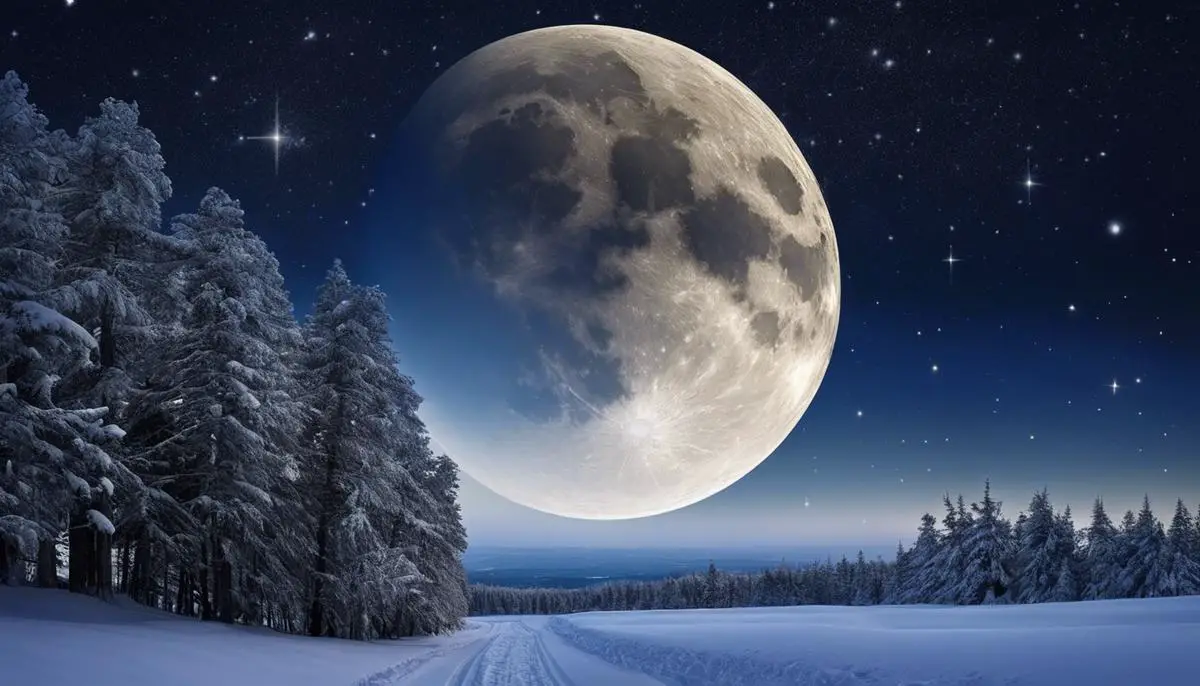Amidst the frosty canvas of February’s chill, the Snow Moon ascends into the sky, casting a silvery glow over the slumbering earth. This celestial phenomenon, marked by the full moon of the shortest month, holds both the allure of the cosmos and the whispers of ancient times. Our orbits align to reveal this lunar majesty, known as the Snow Moon, a beacon that has guided humanity through the ages. As we prepare to unveil the astronomical significance, cultural resonances, scientific studies, and natural impacts surrounding this ethereal orb, let us embark on an enlightening journey through the many facets of the Snow Moon’s splendor.
Astronomical Significance of the Snow Moon
Deciphering the Astronomical Identity of the Snow Moon
Unlike the continuous luminescence of stars, the moon – our celestial companion – orchestrates a monthly dance of shadows and light, culminating into what we term the full moon. The full moon that graces our night sky during the month of February is traditionally dubbed the Snow Moon. This nomenclature, far from being arbitrary, is deeply rooted in the historical practices of various Indigenous peoples of North America, who used lunar phases as a calendar to track the seasons. The Snow Moon title correlates with the typically heavy snowfall during this period, serving both as a descriptor and a reminder of the natural world’s rhythms.
One may inquire: what, aside from its name and seasonal association, astrophysically distinguishes the Snow Moon from its monthly brethren? To address this, we must first understand that while all full moons share the commonality of the earth lying between the sun and the moon, thus fully illuminating the latter, the Snow Moon is marked by several subtle, albeit intriguing, astronomical characteristics.
Orbiting our planet, the moon’s path is not a perfect circle but rather an ellipse. Because of this elliptical orbit, the distance between the Earth and the moon fluctuates throughout the moon’s cycle. The perigee is when the moon is closest to Earth, and the apogee is when it’s farthest. The Snow Moon’s perigee often lies nearer to the Earth than its full moon counterparts, making it appear slightly larger and brighter in the sky – a phenomenon sometimes referred to as the ‘supermoon’. However, this is not an annual guarantee; the categorization of a supermoon is not official astronomical terminology and is subject to variances in definition.
Moreover, the Snow Moon’s timing relative to the earth’s tilt and orbit can affect its trajectory in the sky, altering the angle and duration with which it is visible. A high trajectory across the sky can result in a longer period of illumination during the night, which is notable given February nights are among the longest of the year in the Northern Hemisphere.
In terms of illumination, the intensity and qualities of the moon’s reflected sunlight could be perceived differently. Factors like atmospheric composition, particulate matter from seasonal weather phenomena (such as snowstorms), or even the angle from which moonlight enters the Earth’s atmosphere can subtly affect the chromaticity and intensity of the moon’s visage.
It is these small astronomical variations that define the Snow Moon, making each full moon a singular event to be discerned and appreciated. While it shares the commonality of full illumination with other lunar incarnations, it is distinguished by the intertwining of its orbit with the Earth’s position and the traits of the season it heralds.
In essence, the Snow Moon epitomizes the intricate ballet of celestial mechanics and earthly cycles. Its study invites contemplation of the grandeur and complexity of the cosmos, as well as the cultural interpretations that enrich human understanding of time’s passage. Each full moon possesses its own essence, and the Snow Moon’s unique astronomical factors etch February’s full moon into the cosmic ledger with distinct signatures of light and motion.
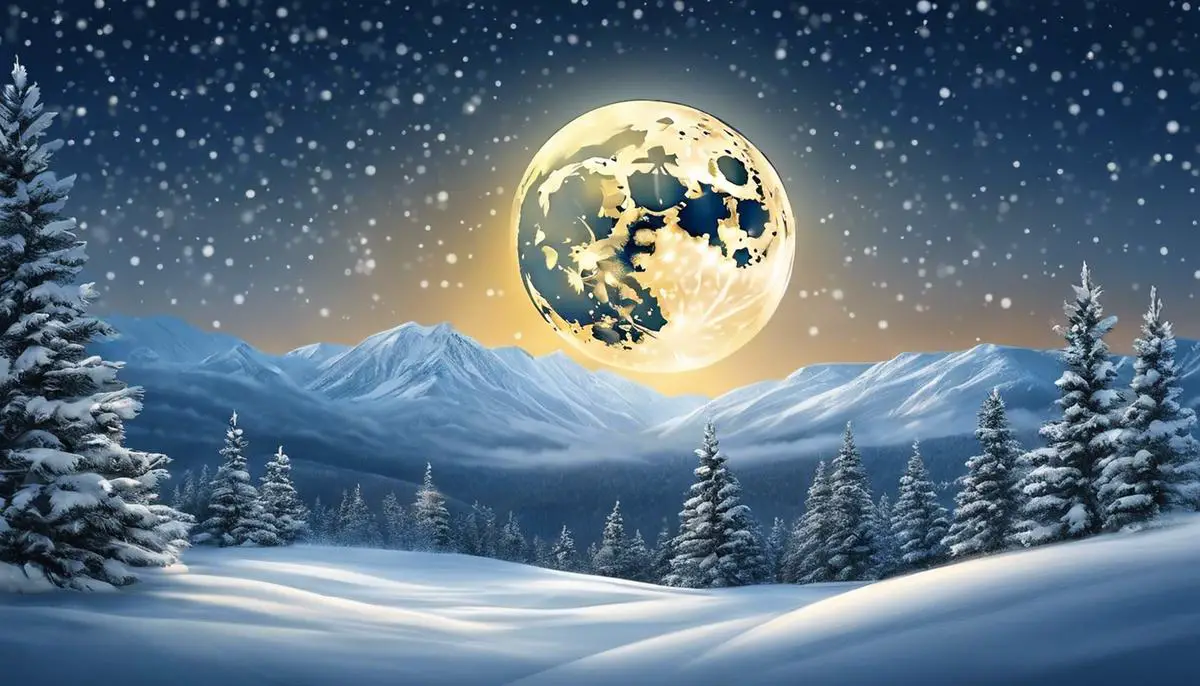
Cultural and Historical Interpretations
Throughout history, various civilizations have gazed upon the night sky with great curiosity and reverence, assigning rich cultural narratives to the lunar phases—one of which is the Snow Moon. As tradition holds, the full moon of February has earned this sobriquet due to its temporal alignment with typically heavy snowfalls in the Northern Hemisphere. This celestial body, then, becomes a natural marker for the passage of time and the rhythm of the seasons.
Cultures across the world have imbued the Snow Moon with diverse interpretations, integrating it into local mythologies and practices. For the Native American tribes, particularly in the northern and eastern regions of the current United States, the Snow Moon was often seen as an augur of the challenging deep-winter month, a period that required intensive preparation and conservation of resources. Names varied among tribes with descriptors like the “Hunger Moon,” due to the scarcity of food, showcasing a clear connection between environmental hardships and the lunar cycle.
European settlers in North America adopted some of these indigenous practices, merging them with their own agrarian calendar and folklore. In this context, the full moon of February became a guiding beacon in their own cycle of sowing and harvesting, linking its appearance with the planning of crops and other agricultural activities.
In East Asia, the Lunisolar Calendar has long been central to the orchestration of festivals and agricultural activities. The Snow Moon, known as the “Budding Moon” in some East Asian cultures, signals the imminent arrival of spring, with associated festivities that celebrate the departing cold and the promise of new growth.
In contrast, in the traditional Islamic lunar calendar, months are not associated with seasons as Islamic months migrate throughout the solar year. Thus, while a “Snow Moon” may have little relevance in certain regions, especially in warmer climates, the lunar phases still hold significant religious importance, marking periods of fasting, pilgrimage, and celebration.
These historically varying interpretations of the Snow Moon provide a vibrant tapestry of human connection to the cosmos. From the nomadic tribes who sought to survive the depths of winter to the agricultural communities who looked to the moon for signs of seasonal change, the Snow Moon has emerged as a universal yet culturally distinct symbol. It stands as a testament to humanity’s enduring search for meaning in the movements of the heavenly bodies and our ceaseless endeavor to harmonize our lives with the rhythms of the natural world.
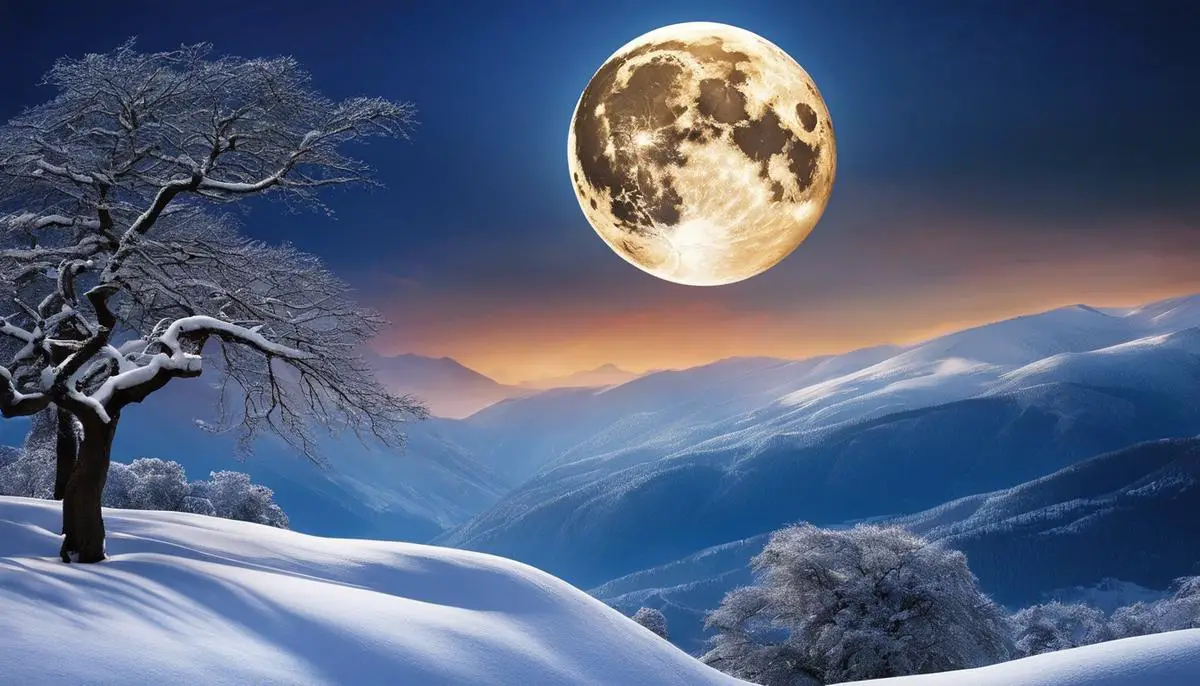
Scientific Observations and Studies
In the rigorous discipline of astrophysics, observational studies pertaining to the Snow Moon venture further than mere folklore and cultural connections. Researchers have delved into the anthropological impacts, measuring how such celestial events shape behaviors and agricultural practices across various societies.
To illustrate, agricultural productivity has often been correlated with lunar cycles. Studies have demonstrated that farmers across certain regions historically relied on the luminosity of the Snow Moon to extend their working hours. This reliance is documented in the timing of crop planting and harvesting, suggesting a synchronization between human activity and the lunar calendar.
Furthermore, recent observational studies have shifted toward the effects of the Snow Moon on animal behavior. The additional light emitted during the full phase of the Snow Moon may affect nocturnal patterns of wildlife. Preliminary data indicates an alteration in the hunting activities and visibility of predators and prey, underscoring a ripple effect throughout the ecosystem.
Snow Moon observance is not only of interest to ecologists and anthropologists. Astronomers conduct photometric analyses comparing the brightness and coloration of the Snow Moon with other full moons throughout the year. These elements provide essential clues about atmospheric composition, as particles suspended in the air can scatter the moonlight and create unique observational signatures.
Additionally, the Snow Moon period is utilized to refine astronomical models. The moon’s apparent path through the night sky offers an opportunity to calibrate instruments and validate celestial navigation techniques.
Finally, the Snow Moon presents a prime opportunity for engaging the public with astronomy. Educational outreach programs harness this period to prompt discussions on lunar science, evoking wonder and deepening the appreciation for celestial dynamics.
While the cultural significance of the Snow Moon is profound, the ongoing research and observation highlight its contribution to a spectrum of scientific inquiries, from the biological to the cosmological. These observations not only enrich scientific understanding but also bridge the ancient human fascination with the moon to modern scientific endeavors.
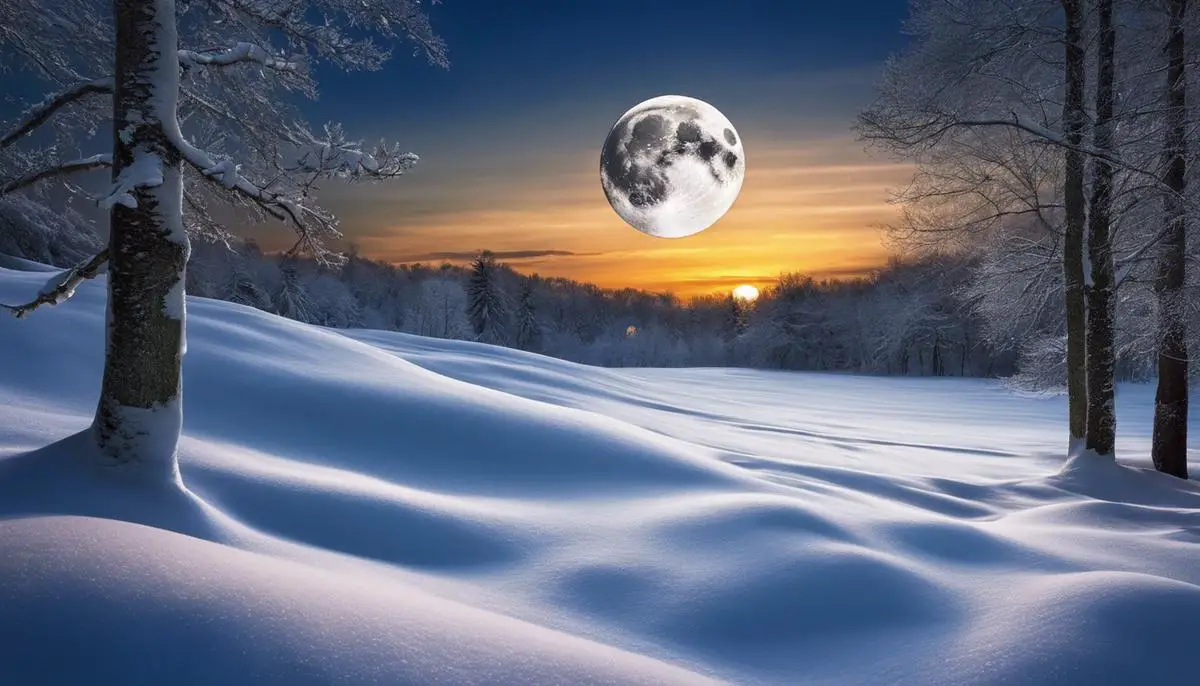
Effects on Earth’s Natural Phenomena
Delving into the effects of the Snow Moon on Earth’s tides, weather, and ecological systems unveils a fascinating tapestry of interconnected phenomena that has enthralled scholars and observers alike. The lunar cycle, characterized by the waxing and waning of the moon, exerts an ineluctable influence on the world’s oceans, resulting in the periodic ebb and flow of tides.
The gravitational interaction between the Earth and the Moon predominantly governs the tidal forces experienced on our planet. During the full moon phase, which includes the Snow Moon typically witnessed in February, the alignment of the Sun, Earth, and Moon—a celestial configuration called syzygy—leads to spring tides. These tides, both higher high tides and lower low tides, are a consequence of the combined gravitational pull of the Sun and the Moon on Earth’s waters.
In the case of the Snow Moon, particularly when it coincides with a perigee—or the closest approach of the Moon to Earth in its elliptical orbit—the effects on tides are amplified. This is due in part to the increased gravitational influence the Moon exercises when at a lesser distance from the Earth, and also to the subtle increases in the tidal forces exerted by the Sun’s gravity. The result is a pronounced tidal range that can significantly affect coastal ecosystems and marine navigation.
Turning to the atmospheric implications, the Snow Moon’s presence, while less directly influential on weather patterns, remains a subject of cultural and anecdotal speculation. Traditional beliefs and lore often suggest correlations between the full moon and weather changes, but the scientific community maintains a consensus that lunar phases have negligible effects on meteorological conditions. Nevertheless, it is important to note that the atmospheric tides, albeit imperceptible to a casual observer, can be attributed in minuscule part to lunar influences; these are, however, vastly overshadowed by solar heating and earthly weather dynamics.
In ecological terms, the illumination provided by the Snow Moon can have tangible effects on the behavior of nocturnal wildlife. Bright moonlit nights alter the foraging activities of predators and the evasion tactics of prey, with an effect on the predation success rates and subsequent survival strategies. Furthermore, the additional light during the Snow Moon can disrupt the natural circadian rhythms of various organisms, impacting functions such as reproduction and migration.
Additionally, the Snow Moon, like other full moons, has been thought to influence plant growth and agricultural practices, although empirical evidence for this remains equivocal. Nonetheless, its cultural importance has traditionally guided the timing of certain agricultural activities, reflective of an era when lunar phases were the primary calendar for farmers.
In conclusion, while the Snow Moon’s influence on Earth’s tides is both significant and measurable, its effects on weather and ecology are more subtle and intertwined with cultural perceptions and folklore. Its true impact lies in the gravitational interplay that it participates in, sculpting the oceanic tides that are so crucial to coastal environments and the species they support. Beyond this, the Snow Moon acts as a beacon in the night sky, illuminating Earth’s nocturnal tapestry in a cycle as old as time itself.
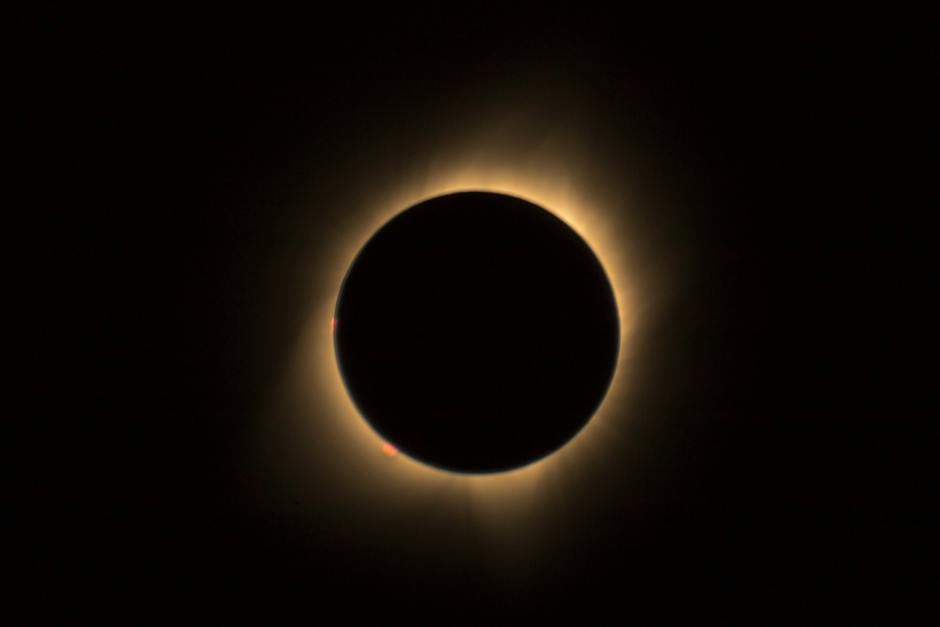
The majestic Snow Moon, with its gentle light piercing the February cold, bridges the vast expanse between the heavens and our home, intertwining celestial mechanics and earthly existence. As the night sky heralds its appearance, we are reminded of the enduring legacy of cultural lore and the ever-expanding pursuit of scientific understanding that encircle this lunar event. The cyclical dance of the Moon and Earth, enveloping us in its rhythmic embrace, resonates through the tides, climates, and life on our planet, bearing testament to the profound and poetic interconnections that define our shared journey under the cosmos.
![]()
